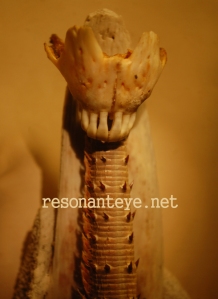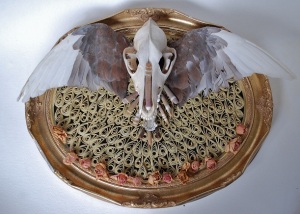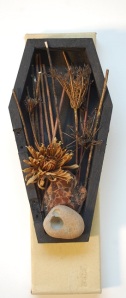Posting some skull mount images!
listing a few photographs of my work as prints here, along with other creepy things.
listing a few photographs of my work as prints here, along with other creepy things.

https://squareup.com/market/anji-marth#category-ad9fa7b0-fed8-4a71-8879-bbd304e8c59c raccoon skull mount with sweetgum pods
For the creepy home, or those who have raccoon as their totem. Ready-to-hang.
This is a salvaged raccoon skull. I do not know how he died, as he is nature-found. He’s been cleaned, sanitized, and then stained and painted with oil pigment, and mounted firmly in a box filled with dried sweetgum pods, raccoon ribs, coyote teeth (humanely collected), and cornered by hog teeth and bird bones. Everything secured with cured bone glue.
he will ship in a well-protected box within a box.
The box is thin pine, backed with felt, signed on the reverse.
approximately 10×10″.
Published on: Jul 1, 2012
 I worked on this today, with help from Hawkins.
I worked on this today, with help from Hawkins.
It’s a commission for a friend; I was working on it before but they asked me to build a mount for them, and finishing this ended up fitting their concept perfectly. (I do have some things like this for sale, go here to buy those, or see them.)
All that’s left to do is seal it.
Pig skull, deer and coyote jaws, deer, dog, and badger bones- medical-grade gauze circa 1943, and oil paint.
I used bone glue, hot glue, twine, and adhesive plaster to construct it, and to make the joints solid.
It’s mounted on a square piece of maple plywood. It has taken me a few days of solid effort, and a few weeks of concept/articulation research, to make this one. Hawkins helped assort and assemble the structure – having his mind on the project was extremely helpful.
More images after the jump.
Published on: Dec 7, 2011
Published on: Mar 16, 2012
 How to get the bones from animal remains you find that still have a bit of meat on them, and which are not dried out:
How to get the bones from animal remains you find that still have a bit of meat on them, and which are not dried out:
Wear disposable gloves. Wild animals carry loads of diseases which you can in fact succumb to, such as rabies, flu, and even leprosy (YES, leprosy).
This is the low-investment method. You can also bury or macerate the remains to get the bones; but maggot cleaning will be less involved. You could get a beetle box, but maggot cleaning is less upkeep.
TEAL DEER:
DON’T FUCKING BOIL OR BLEACH BONES! IT DESTROYS THEM!
 How to disinfect feathers (legal ones- domestic and game birds)
How to disinfect feathers (legal ones- domestic and game birds)
Find out if they’re legal to own!
Wear disposable gloves.
Be especially cautious with feathers, because bird flu is an actual thing. So is west nile virus, salmonella, and more…
TEAL DEER? MOST FEATHERS ARE ILLEGAL, DON’T BE A DUMBASS.
(you can find my work in these materials here or here)
originally written on: Aug 1, 2012
updated today
Three taxidermy bats- two indonesian bats (chemically preserved) and one northwest bat, humanely collected, preserved with salt, disinfectant materials, and time, (completely mummified and sanitary) and mounted on a birch plaque with mouse and vole bones and preserved hawkmoths and cicada shells. All have been sanitized and dried completely, handled with care.
I adore bats. I think they’re amazing, beautiful creatures, and I have been donating to a few projects meant to combat white-nose fungus, which has been killing off bats across the Americas for a while now. It’s really sad because bats keep all insects in check, plus they are ADORABLE.
Ships nestled carefully in protective packaging, to the US only. $200 includes shipping, handling, tracking, and insurance (USPS)
Plaque is approximately 6×15″. Bats are mummified completely, all bones are sealed and odorless.

Originally Published on: Mar 19, 2012
St. Roch is the patron saint of dogs.
He is also a preventer of the plague.
he remained behind during the plague to treat people; he himself became ill. he went into the forest to die, but a dog (who is not named in any story) brought him bread and licked his wounds, saving him.
This is made from a grey fox skull, sea urchins, rockdove wings, and quilling done with paper I made myself. the tattered roses are preserved in glycerin and poly so they will stay just as they are. All mounted in a gilded frame.
I’ve got another quilling project in the works, I’ll post some progress shots this week.

 Here are some photos of all the things which I just got back from the speakeasy art show.
Here are some photos of all the things which I just got back from the speakeasy art show.
Some of these will be for sale at MY SKULL AND NATURE SHOP, others are already spoken for, waiting to be picked up.
The hardest thing about selling these (besides the amount of logical work that goes into shipping them) is parting with them. I really feel the creatures, you know? Like each one has a definite personality, to me. So when someone buys them it’s like saying goodbye to a friend.
At least awesome people buy them. That makes it a lot easier.
Click through to see more photos.
These were, until now, on display at the Oak Street Speakeasy in Eugene, Oregon. I have had three waves of art showed there over the past year, along with Jameson’s, the Horsehead, and Unfine art museum. These are my favorite places to hang my work- the crowds that go there all seem to like it, and I get good feedback from the folks in these places.
Plus, the speakeasy is where every good death metal and sludge doom band plays, here in town. So of course I like hanging my skulls there.
 what I ended up working with today. I’ll post the sasquatch tomorrow- he isn’t done yet.
what I ended up working with today. I’ll post the sasquatch tomorrow- he isn’t done yet.
This is a unique website which will require a more modern browser to work!
Please upgrade today!